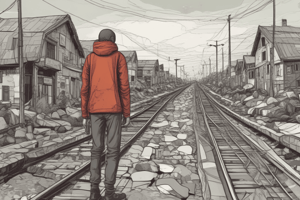Podcast
Questions and Answers
What typically limits access to needed healthcare for low-income individuals?
What typically limits access to needed healthcare for low-income individuals?
- Increased insurance coverage
- Higher pain tolerance due to race
- Access to specialized care
- Affordability of expensive treatments (correct)
What is a major consequence of conducting medical research primarily on men?
What is a major consequence of conducting medical research primarily on men?
- It increases the number of treatments available for all genders.
- It leads to better outcomes for women.
- It eliminates healthcare disparities between genders.
- It develops treatment protocols that may not be effective for women. (correct)
Which stereotype can affect the pain treatment given to Black patients?
Which stereotype can affect the pain treatment given to Black patients?
- Perception that Black patients are less compliant with treatment.
- Expectation that Black patients report pain more frequently.
- Belief that Black patients seek less medical care.
- Assumption that Black patients have a higher pain tolerance. (correct)
Urbanization primarily leads to a shift from which of the following to centralized cities?
Urbanization primarily leads to a shift from which of the following to centralized cities?
What process occurs when a significant number of families move from densely populated city centers to suburbs?
What process occurs when a significant number of families move from densely populated city centers to suburbs?
What is a result of gentrification in lower-income neighborhoods?
What is a result of gentrification in lower-income neighborhoods?
What does industrialization typically develop according to the context provided?
What does industrialization typically develop according to the context provided?
Which factor can significantly contribute to the decline of urban areas?
Which factor can significantly contribute to the decline of urban areas?
What are social movement strategies primarily concerned with?
What are social movement strategies primarily concerned with?
Which of the following is an example of a social movement tactic?
Which of the following is an example of a social movement tactic?
What typically marks the beginning of a social movement's organization?
What typically marks the beginning of a social movement's organization?
What defines absolute poverty?
What defines absolute poverty?
What is one possible outcome of a social movement, regardless of its success or failure?
What is one possible outcome of a social movement, regardless of its success or failure?
How is relative poverty distinguished from absolute poverty?
How is relative poverty distinguished from absolute poverty?
Which stage of the demographic transition model describes a period of high birth and death rates?
Which stage of the demographic transition model describes a period of high birth and death rates?
Which of the following is a consequence of social stratification related to poverty?
Which of the following is a consequence of social stratification related to poverty?
In what stage of the demographic transition does the death rate typically begin to drop?
In what stage of the demographic transition does the death rate typically begin to drop?
What does the demographic transition model illustrate about population changes?
What does the demographic transition model illustrate about population changes?
What role does the poverty line play in identifying poverty?
What role does the poverty line play in identifying poverty?
Which factor is NOT associated with the demographic transition from high to low birth and death rates?
Which factor is NOT associated with the demographic transition from high to low birth and death rates?
Which scenario exemplifies relative poverty?
Which scenario exemplifies relative poverty?
What characterizes social exclusion in the context of poverty?
What characterizes social exclusion in the context of poverty?
What is a significant impact of social stratification on healthcare?
What is a significant impact of social stratification on healthcare?
Why might unhoused individuals be physically removed from public spaces?
Why might unhoused individuals be physically removed from public spaces?
Which demographic groups are most affected by health disparities?
Which demographic groups are most affected by health disparities?
What is a key macro-level factor influencing individual health outcomes?
What is a key macro-level factor influencing individual health outcomes?
What health outcome is notably higher among Black individuals compared to other racial groups?
What health outcome is notably higher among Black individuals compared to other racial groups?
How do healthcare disparities generally affect marginalized demographic groups?
How do healthcare disparities generally affect marginalized demographic groups?
What factor contributes to increased life expectancy among women compared to men in the United States?
What factor contributes to increased life expectancy among women compared to men in the United States?
Which aspect of the healthcare system is most likely to exacerbate healthcare disparities?
Which aspect of the healthcare system is most likely to exacerbate healthcare disparities?
Which of the following is considered a micro-level factor affecting health outcomes?
Which of the following is considered a micro-level factor affecting health outcomes?
How does social class status influence exposure to health risks?
How does social class status influence exposure to health risks?
What happens to birth rates as societies transition from urbanization to Stage 3 of the demographic transition model?
What happens to birth rates as societies transition from urbanization to Stage 3 of the demographic transition model?
According to the Malthusian theory of population growth, what is the expected relationship between population growth and resource availability?
According to the Malthusian theory of population growth, what is the expected relationship between population growth and resource availability?
What are positive checks in the context of the Malthusian theory?
What are positive checks in the context of the Malthusian theory?
Which type of population pyramid is characterized by a broad base and a narrow top, indicating a developing country with high birth and death rates?
Which type of population pyramid is characterized by a broad base and a narrow top, indicating a developing country with high birth and death rates?
What is a characteristic feature of a stationary population pyramid?
What is a characteristic feature of a stationary population pyramid?
In Stage 4 of the demographic transition model, which statement is true regarding population growth?
In Stage 4 of the demographic transition model, which statement is true regarding population growth?
What is a potential outcome in Stage 5 of the demographic transition model?
What is a potential outcome in Stage 5 of the demographic transition model?
How do small-scale positive checks differ from large-scale positive checks?
How do small-scale positive checks differ from large-scale positive checks?
What characterizes absolute poverty?
What characterizes absolute poverty?
How does relative poverty differ from absolute poverty?
How does relative poverty differ from absolute poverty?
What is a significant consequence of social exclusion related to poverty?
What is a significant consequence of social exclusion related to poverty?
Which statement about the poverty line is correct?
Which statement about the poverty line is correct?
Which of the following best describes the impact of social stratification on healthcare?
Which of the following best describes the impact of social stratification on healthcare?
What socio-economic factors contribute to disparities in health outcomes?
What socio-economic factors contribute to disparities in health outcomes?
Which group is likely to experience a higher incidence of certain health issues?
Which group is likely to experience a higher incidence of certain health issues?
What factor is most often associated with healthcare disparities?
What factor is most often associated with healthcare disparities?
What demographic characteristic is linked to life expectancy disparities?
What demographic characteristic is linked to life expectancy disparities?
Which of the following is NOT a factor affecting an individual's health outcomes?
Which of the following is NOT a factor affecting an individual's health outcomes?
Flashcards are hidden until you start studying
Study Notes
Poverty
- Poverty refers to a lack of economic resources, like lower income and fewer assets associated with lower socioeconomic status.
- Poverty can occur at individual, family, community, and national levels.
- Absolute poverty refers to the inability to secure basic necessities of life, such as food, clean water, and safe shelter. The poverty line in the United States determines who qualifies for social services like food stamps and subsidized housing.
- Relative poverty is the inability to meet living standards of the society, even if basic needs are met. It means living below the average standard of living.
Social Exclusion
- Social exclusion marginalizes individuals based on stigmatized identities like mental illness, and disadvantaged situations like poverty, limiting their full participation in social life.
- This exclusion can cause individuals to be disconnected from society and unable to engage in common practices like earning money through work.
Health & Healthcare Disparities
- Health disparities are inequalities in health outcomes, such as rates of illness or death, which often impact disadvantaged groups like racial minorities and lower-income individuals more severely.
- Health outcomes are shaped by social institutions and individual health behaviors.
- Wealthier individuals are often protected from health risks in the physical environment, like pollution, compared to lower-income individuals.
- Women generally live longer than men.
- Racial minorities often experience higher rates of certain diseases, such as Black people having the highest rates of hypertension compared to other racial groups.
Healthcare Disparities
- Healthcare disparities refer to inequalities in access to healthcare services, often due to relative poverty, accessibility issues like language barriers or distance from clinics, and institutional discrimination.
- Wealthier individuals have greater access to specialized care, while lower-income individuals may not be able to afford expensive treatments.
- Men have historically been the subjects of medical research, leading to a gender disparity in healthcare, as treatments are based on data from men only.
- Racial disparities exist in healthcare, with some medical professionals holding stereotypes about the pain tolerance of Black patients.
Urbanization
- Urbanization is the shift of individuals from rural agricultural communities to centralized cities.
- Industrialization and the expansion of commerce in cities drive urbanization.
- As cities grow, middle and upper-class families often move to suburbs for more space.
- Suburbanization can contribute to the decline of urban areas as wealth is transferred to the suburbs.
- Urban renewal attempts to revitalize declining urban areas through infrastructure and building renovations.
- Gentrification involves revitalizing lower-income neighborhoods with new, higher-income residents, often leading to increased property values.
Social Movements
- Social movements are sustained efforts by individuals with shared values and goals, often lasting for years.
- Notable social movements in the US include the Civil Rights Movement, anti-war movements, and environmental movements.
- Social movement strategies involve mobilizing resources like people and money to promote goals.
- Social movement tactics are specific actions like protests, strikes, and marches.
- Social movements typically start with an idea, become more organized, and eventually succeed or fail.
- Social movements can create lasting change even if they don't achieve specific goals.
Demographic Change
- Demographic shifts are changes in population characteristics over time, such as total population and average lifespan.
- The demographic transition model explains demographic shifts from high birth and death rates to low birth and death rates, typically occurring in predictable stages:
- Stage 1: High birth and death rates, slow population growth
- Stage 2: Industrialization, lower death rates due to improved health and access to resources, rapid population growth
- Stage 3: Urbanization, continued growth, and declining birth rate due to increased access to contraception
- Stage 4: Low birth and death rates, slow population growth, stable population
- Stage 5: Very low birth rates, potential population decline (hypothetical)
Malthusian Theory of Population Growth
- This theory suggests that population increases exponentially while resources increase linearly at a slower rate.
- Population growth can be slowed by preventative checks, like decreasing birth rate through contraceptives, or positive checks, which increase death rate involuntarily.
- Positive checks can be small-scale, like increased death from a flu virus, or large-scale, like widespread famine, disease epidemics, or wars, slowing or halting population growth.
Population Growth & Decline
- Population pyramids graph the demographics of a society to show changes in population.
- Three types of pyramids exist:
- Expanding pyramids have broad bases (many young people) and narrow tops (few older individuals).
- Stationary pyramids have broad bases and tops, with a stable population.
- Contracting pyramids have narrower bases and are characteristic of declining populations.
Poverty
- Poverty is a lack of economic resources, often linked to low income and fewer assets.
- Absolute poverty means not having basic necessities like food, clean water, and safe shelter.
- The poverty line determines who qualifies for social services in the U.S.
- Relative poverty is when someone can meet basic needs but their living standards are below average.
Social Exclusion
- Social exclusion is the marginalization of individuals due to stigmatized identities or disadvantaged situations, hindering full participation in society.
- Poverty contributes to social exclusion, disconnecting individuals from mainstream activities like earning money.
Health and Healthcare Disparities
- Health disparities are inequalities in health outcomes within society, often impacting disadvantaged groups more severely.
- Sociologists view health as shaped by both social factors (institutions) and individual behaviors.
- Macro-level factors like environment, employment, and education influence health outcomes.
- Micro-level factors like lifestyle choices (diet, exercise) also play a part.
- Healthcare disparities are inequalities in access to healthcare due to systemic issues like poverty, accessibility problems, and discrimination.
- Wealthier individuals generally have better access to specialized care, while those with lower incomes often can't afford expensive treatments.
Urbanization
- Urbanization is the shift from rural, agricultural communities to centralized cities.
- Industrialization drives urban growth, as the need for workers in cities increases with expanding businesses.
- Suburbanization is the population migration from cities to suburbs, often due to a desire for more space and less density.
- Gentrification is the revitalization of lower-income neighborhoods by new, higher-income residents, often raising property values.
Population Growth and Decline
- Population pyramids are graphs that show the demographics of a society, providing insights into population changes.
- Expanding pyramids (broad base, narrow top) indicate a growing population, often in developing countries.
- Stationary pyramids (broad base, broad top) reflect a stable population, typical of developed countries.
- Contracting pyramids (narrower base than middle) suggest a declining population size, also common in developed countries.
Fertility and Mortality
- Fertility rates measure population increases due to births.
- Mortality rates measure population declines due to deaths.
- Total fertility rate (TFR) is the average number of children born per woman in her lifetime. A TFR above 2 indicates population growth, while below 2 suggests a shrinking population.
- Crude birth rate (CBR) is the number of live births per year per 1,000 people, providing a rough estimate of population growth based solely on births.
- Age-specific fertility rate (ASFR) measures births per 1,000 women within a certain age group.
- Crude death rate is the number of deaths per year per 1,000 people.
- Age-specific mortality rates track deaths within particular age groups.
- The infant mortality rate measures the number of deaths of children under one year old per 1,000 live births in a year.
Studying That Suits You
Use AI to generate personalized quizzes and flashcards to suit your learning preferences.




